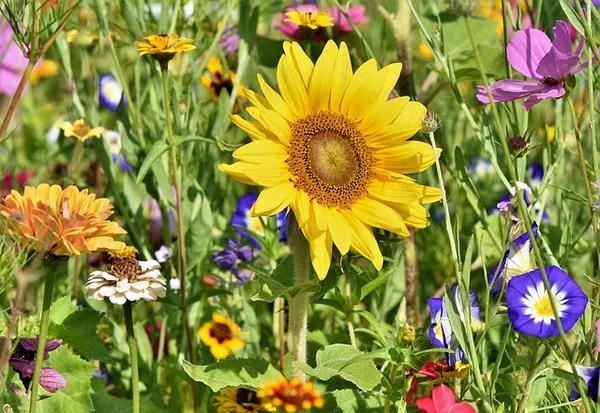Sunflowers (Helianthus annuus) are iconic symbols of natural beauty, known for their vibrant yellow petals and towering heights. These stunning plants have captivated the interest of gardeners, scientists, and nature enthusiasts alike. Understanding the growth timeline of sunflowers is not only fascinating but also crucial for cultivating these cheerful blooms successfully. From seed germination to full maturity, let’s delve into the various stages of sunflower growth.
Stage 1: Germination (Day 1 – 10)
The journey of a sunflower begins with a tiny seed. Germination, the initial stage of growth, involves the awakening of the embryo within the seed. Under optimal conditions of moisture, temperature, and soil quality, sunflower seeds typically germinate within 5 to 10 days after planting. During this period, the seed absorbs water and swells, causing the seed coat to split. A small root emerges, anchoring the seedling into the soil, while a shoot begins to push its way towards the surface.
Stage 2: Seedling Establishment (Day 10 – 21)
As the shoot continues to elongate, the first leaves, known as cotyledons, unfurl. These initial leaves provide essential nutrients to the young plant until true leaves form. The true leaves, which develop after the cotyledons, are characteristic of the sunflower’s distinct heart shape. During this phase, the sunflower seedling is establishing a strong root system to support future growth. Adequate sunlight and proper watering are essential for promoting healthy root development.
Stage 3: Vegetative Growth (Day 21 – 50)
The vegetative growth stage is marked by rapid development of the sunflower’s stem and leaves. The plant focuses its energy on increasing its size and capturing sunlight for photosynthesis. At this point, the sunflower is particularly sensitive to environmental factors such as temperature and nutrient availability. Well-draining soil and regular fertilization contribute to robust growth during this phase.
Stage 4: Bud Formation (Day 50 – 60)
Around the 50th day of growth, the sunflower plant transitions from vegetative growth to reproductive growth. The apical meristem, a specialized area of cell division at the top of the plant, shifts its focus from producing leaves to forming flower buds. These buds are tightly wrapped structures containing the future petals, disk florets, and reproductive organs of the sunflower. The plant’s energy is directed towards these buds, preparing for the forthcoming blossoms.
Stage 5: Blooming (Day 60 – 90)
One of the most anticipated stages in a sunflower’s lifecycle is its blooming phase. Depending on the sunflower variety and environmental conditions, this typically occurs between the 60th and 90th day of growth. The tightly wound flower buds unfurl, revealing the vibrant yellow petals that encompass the central disk florets. The disk florets, which are small tubular structures at the center of the bloom, contain the sunflower’s reproductive parts.
The blooming phase is relatively short-lived, usually lasting only a few weeks. However, during this time, the sunflower provides a picturesque display, attracting pollinators and admirers alike. It’s essential to provide ample sunlight and appropriate spacing to allow the sunflowers to fully express their beauty.
Stage 6: Seed Maturation (Day 90 – 120)
As the blooms begin to fade, the sunflower enters the seed maturation stage. The disk florets, once bright and vibrant, gradually turn brown, indicating the formation of seeds. The sunflower’s iconic appearance, with its yellow petals surrounding the brown disk, remains captivating even in its post-blooming phase. As the seeds mature, they accumulate nutrients and energy, ensuring the viability of the next generation.
Stage 7: Harvest (Day 120 – 150)
The timing of sunflower harvest depends on the intended use of the seeds. For those interested in collecting sunflower seeds for consumption or oil extraction, it’s crucial to wait until the seeds are fully mature. Signs of maturity include a brown and dried appearance of the disk florets, and the back of the sunflower head turning from green to yellow.
If the goal is to harvest sunflowers for decorative purposes, it’s possible to cut the flower heads once the blooms have faded but before the seeds fully mature. These dried sunflower heads can be used in floral arrangements or left in the garden to provide visual interest throughout the colder months.
Conclusion:
The journey of a sunflower from a tiny seed to a majestic bloom is a remarkable testament to the wonders of nature. The growth timeline of sunflowers spans approximately 120 to 150 days, encompassing various stages of development. From germination to seed maturation, each phase plays a crucial role in shaping the ultimate beauty and vitality of the sunflower.
Successful cultivation of sunflowers requires a combination of favorable environmental conditions , proper care, and patience. Providing well-draining soil, adequate sunlight, and timely watering can significantly contribute to the healthy growth of sunflowers. By understanding the intricacies of each growth stage, gardeners and enthusiasts can enhance their appreciation for these cheerful and iconic plants. Whether adorning gardens, fields, or bouquets, sunflowers continue to inspire with their vibrant presence and natural splendor.


